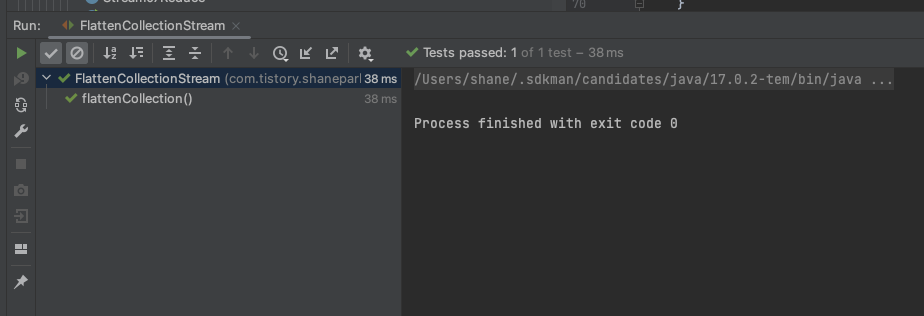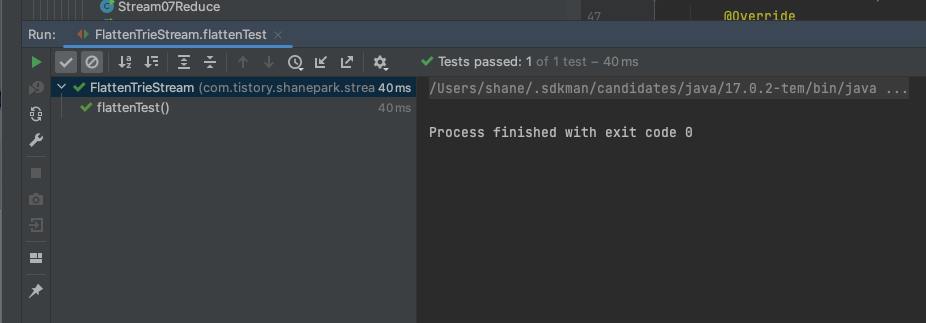Intro
TREE 형태로 만들어둔 메뉴 목록을 평면화해야 하는 일이 있었습니다. Stream의 flatMap을 활용하면 이중 컬렉션의 평면화를 아주 쉽게 할 수 있는데, 트리 전체를 평면화 시키는건 코드를 깔끔하게 작성하는데 고민이 많았습니다.
스트림을 활용해 트리 형태의 그래프를 평면화 시키는 작업을 한번 해 보도록 하겠습니다.
이중 컬렉션 평면화
가장 먼저 이중 컬렉션의 평면화를 몸풀기로 진행 해 보도록 하겠습니다.
이 작업은 필요한 경우가 잦아 모두 한번쯤은 작성해 해 보셨을거에요.
- 일단 중첩 컬렉션을 평면화시키는 메서드를 가진 인터페이스를 선언 하고
javainterface CollectionFlatter<T> { Collection<T> flatten(Collection<Collection<T>> collection); }
- 거기에 맞는 테스트 코드를 작성 해 줍니다.
java@Test public void flattenCollection() { // Given String SUB1_TXT1 = "sub1_txt1"; String SUB1_TXT2 = "sub1_txt2"; String SUB2_TXT1 = "sub2_txt1"; String SUB2_TXT2 = "sub2_txt2"; List<List<String>> list = new ArrayList<>(); ArrayList<String> sub1 = new ArrayList<>(); sub1.add(SUB1_TXT1); sub1.add(SUB1_TXT2); ArrayList<String> sub2 = new ArrayList<>(); sub1.add(SUB2_TXT1); sub1.add(SUB2_TXT2); list.add(sub1); list.add(sub2); // When CollectionFlatter flatter = null; Collection flatData = flatter.flatten(list); // Then Assertions.assertThat(flatData).containsExactlyInAnyOrder(SUB1_TXT1, SUB1_TXT2, SUB2_TXT1, SUB2_TXT2); }
- 이제 해당 인터페이스를 구현 해 줍니다. 두가지 방법으로 진행 해 볼텐데요, 전형적인 for 반복문과 스트림을 활용 해 보도록 하겠습니다.
for loop
전형적인 이중 for문 구조 입니다. 반환할 컬렉션 (여기에서는 ArrayList)를 선언 해 준 후에 깊은 순회를 하며 요소를 모두 해당 컬렉션에 추가 해 준 뒤, 최종적으로 반환까지 해 줍니다.
javaclass CollectionForFlatter<T> implements CollectionFlatter<T> { @Override public Collection flatten(Collection<Collection<T>> collection) { Collection<T> result = new ArrayList<>(); for (Collection<T> subCollection : collection) { for (T t : subCollection) { result.add(t); } } return result; } }
stream
Stream에는 flatMap 메서드가 있는데, 이를 활용하면 매우 간단하게 스트림을 평면화 할 수 있습니다.
javaclass CollectionStreamFlatter<T> implements CollectionFlatter<T> { @Override public Collection flatten(Collection<Collection<T>> collection) { return collection.stream() .flatMap(c -> c.stream()) .collect(Collectors.toList()); } }
자바 8에서 추가된 메소드 레퍼런스를 활용할 수 있습니다.
javaclass CollectionStreamFlatter<T> implements CollectionFlatter<T> { @Override public Collection flatten(Collection<Collection<T>> collection) { return collection.stream() .flatMap(Collection::stream) .collect(Collectors.toList()); } }
테스트
이제 두가지 구현을 모두 테스트 해 봅니다.
javapackage com.tistory.shanepark.stream.flatten; import org.assertj.core.api.Assertions; import org.junit.jupiter.api.Test; import java.util.ArrayList; import java.util.Collection; import java.util.List; import java.util.stream.Collectors; public class FlattenCollectionStream { @Test public void flattenCollection() { // Given String SUB1_TXT1 = "sub1_txt1"; String SUB1_TXT2 = "sub1_txt2"; String SUB2_TXT1 = "sub2_txt1"; String SUB2_TXT2 = "sub2_txt2"; List<List<String>> list = new ArrayList<>(); ArrayList<String> sub1 = new ArrayList<>(); sub1.add(SUB1_TXT1); sub1.add(SUB1_TXT2); ArrayList<String> sub2 = new ArrayList<>(); sub1.add(SUB2_TXT1); sub1.add(SUB2_TXT2); list.add(sub1); list.add(sub2); // When CollectionFlatter flatter1 = new CollectionStreamFlatter(); Collection flatData1 = flatter1.flatten(list); CollectionFlatter flatter2 = new CollectionForFlatter(); Collection flatData2 = flatter2.flatten(list); // Then Assertions.assertThat(flatData1).containsExactlyInAnyOrder(SUB1_TXT1, SUB1_TXT2, SUB2_TXT1, SUB2_TXT2); Assertions.assertThat(flatData2).containsExactlyInAnyOrder(SUB1_TXT1, SUB1_TXT2, SUB2_TXT1, SUB2_TXT2); } class CollectionStreamFlatter<T> implements CollectionFlatter<T> { @Override public Collection flatten(Collection<Collection<T>> collection) { return collection.stream() .flatMap(c -> c.stream()) .collect(Collectors.toList()); } } class CollectionForFlatter<T> implements CollectionFlatter<T> { @Override public Collection flatten(Collection<Collection<T>> collection) { Collection<T> result = new ArrayList<>(); for (Collection<T> subCollection : collection) { for (T t : subCollection) { result.add(t); } } return result; } } interface CollectionFlatter<T> { Collection<T> flatten(Collection<Collection<T>> collection); } }

실행 결과 아무런 문제 없이 성공합니다.
이중 트리 평면화
이번에는 아래와 같은 구조를 가진 트리를 평면화 시켜 보도록 하겠습니다.
javaclass Node { String value; List<Node> children = new ArrayList<>(); public Node(String value) { this.value = value; } Node addChild(String value) { Node child = new Node(value); children.add(child); return child; } }
그리고 마찬가지로 테스트 코드를 작성 합니다.
java@Test public void flattenTest() { // Given Node node1 = new Node("node1"); Node node2 = new Node("node2"); List<Node> heads = List.of(node2, node1); Node node1_1 = node1.addChild("node1_1"); Node node1_2 = node1.addChild("node1_2"); // When NodeFlatter flatter = new StreamNodeFlatter(); NodeFlatter flatter2 = new ForNodeFlatter(); // Then assertThat(flatter.flatten(heads).stream()).containsExactlyInAnyOrder(node1, node1_1, node1_2, node2); assertThat(flatter2.flatten(heads).stream()).containsExactlyInAnyOrder(node1, node1_1, node1_2, node2); }
하나씩 구현 해 봅니다.
ForNodeFlatter
javaclass ForNodeFlatter implements NodeFlatter { @Override public List<Node> flatten(List<Node> nodes) { List<Node> result = new ArrayList<>(); for (Node node : nodes) { result.add(node); for (Node child : node.children) { result.add(child); } } return result; } }
사실 위에서 이중 컬렉션을 평면화 할 때도 가능하긴 했는데, addAll 메서드를 사용하면 코드상에서 indent depth를 하나 줄일 수 있습니다.
javaclass ForNodeFlatter implements NodeFlatter { @Override public List<Node> flatten(List<Node> nodes) { List<Node> result = new ArrayList<>(); for (Node node : nodes) { result.add(node); result.addAll(node.children); } return result; } }
트리 구조에서는 스스로 및 자식 노드들을 추가 하기 때문에 스스로를 추가하는 add가 하나 더 있는 모습 입니다.
StreamNodeFlatter
이번에는 스트림을 이용 해 보도록 하겠습니다.
javaclass StreamNodeFlatter implements NodeFlatter { @Override public List<Node> flatten(List<Node> nodes) { return nodes.stream() .flatMap(node -> Stream.concat(Stream.of(node), node.children.stream())) .collect(Collectors.toList()); } }
스트림에서는 concat 메서드를 활용 하면 두개의 스트림을 합칠 수 있는데요, 그걸 활용해서 스스로와 자식노드들을 하나의 스트림으로 평면화 시킨 모습입니다.

역시 무사히 테스트 코드를 통과 합니다.
다중 트리 평면화
이번에는 해당 트리의 최고 depth를 알 수 없는 상태라고 가정 해 보겠습니다.
이때는 어떤식으로 평면화를 해야 할까요? 깊이우선이 되었건, 너비우선이 되었건 완전탐색을 해야 한다는건 변함이 없습니다.
이번에도 테스트 코드를 먼저 작성 하도록 하겠습니다.
java@Test public void flattenTest() { // Given List<Node> heads = new ArrayList<>(); Node node1 = new Node("node1"); Node node2 = new Node("node2"); heads.add(node2); heads.add(node1); Node node1_1 = node1.addChild("node1_1"); Node node1_2 = node1.addChild("node1_2"); Node node1_1_1 = node1_1.addChild("node1_1_1"); Node node1_1_2 = node1_1.addChild("node1_1_2"); Node node1_1_1_1 = node1_1_1.addChild("node1_1_1_1"); Node node1_1_1_2 = node1_1_1.addChild("node1_1_1_2"); Node node1_2_1 = node1_2.addChild("node1_2_1"); Node node1_2_2 = node1_2.addChild("node1_2_2"); // When NodeFlatter flatter = new StreamNodeFlatter(); NodeFlatter flatter2 = new ForNodeFlatter(); // Then assertThat(flatter.flatten(heads).stream()) .containsExactlyInAnyOrder(node1, node1_1, node1_1_1, node1_1_1_1, node1_1_1_2, node1_1_2, node1_2, node1_2_1, node1_2_2, node2); assertThat(flatter2.flatten(heads).stream()) .containsExactlyInAnyOrder(node1, node1_1, node1_1_1, node1_1_1_1, node1_1_1_2, node1_1_2, node1_2, node1_2_1, node1_2_2, node2); }
다중 트리의 경우에는 재귀적으로 처리하면 코드를 깔끔하게 작성 할 수 있습니다.
다만, 트리가 아니고 사이클이 존재하는 경우에는 무한재귀에 빠질 수 있으니 유의해야 합니다.
ForNodeFlatter
javaclass ForNodeFlatter implements NodeFlatter { @Override public List<Node> flatten(List<Node> nodes) { List<Node> result = new ArrayList<>(); for (Node node : nodes) { result.add(node); result.addAll(flatten(node.children)); } return result; } }
다중트리지만, 재귀 형태로 인해 코드 자체의 복잡성은 거의 차이가 없습니다.
StreamNodeFlatter
javaclass StreamNodeFlatter implements NodeFlatter { @Override public List<Node> flatten(List<Node> nodes) { return nodes.stream() .flatMap(node -> Stream.concat(Stream.of(node), flatten(node.children).stream())) .collect(Collectors.toList()); } }
스트림의 경우에는 코드가 더욱 깔끔하게 떨어집니다.
물론 readability 측면에서는 조금 아쉽기도 한데요 메서드를 분리하는 방법이 있을 수 있겠네요.
javaclass StreamNodeFlatter implements NodeFlatter { @Override public List<Node> flatten(List<Node> nodes) { return nodes.stream() .flatMap(node -> flatStream(node)) .collect(Collectors.toList()); } private Stream<Node> flatStream(Node node) { return Stream.concat(Stream.of(node), flatten(node.children).stream()); } }

테스트 역시 성공합니다.
지금까지 스트림을 평면화 하는 방법에 대해 알아보았습니다.
감사합니다.
'Programming > Java' 카테고리의 다른 글
| [Java] Primitive vs Wrapper class 기본형 타입과 래퍼클래스 (0) | 2023.01.12 |
|---|---|
| [Java] 불변객체(Immutable Object)의 JSON 직렬화 및 역직렬화 (0) | 2022.11.20 |
| Armeria 튜토리얼 따라해보기 (0) | 2022.08.20 |
| [Java] Optional 올바르게 사용하기 (0) | 2022.07.21 |
| [Java] switch 문이 if-else 보다 효율적인 이유 (0) | 2022.07.09 |